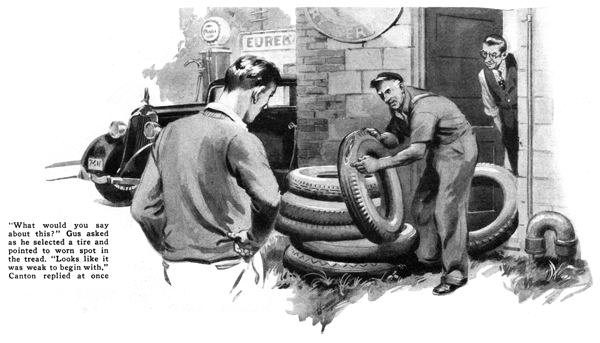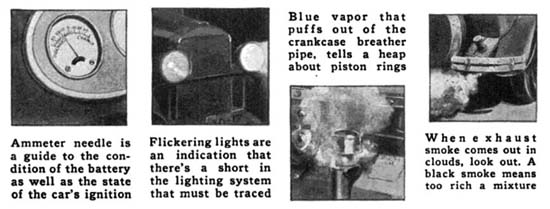October 1933
PLAIN CLUES TO MOTOR ILLS
by Martin Bunn
Many Things You Can Learn About an Engine
by Using Your Eyes and Ears.

Young Henry Canton jabbed his toe viciously at the starter button. A feeble whir was the only response.
"It's no use, Hank," insisted Gus Wilson who was standing with one foot poised on the running board. "Your battery's deader than a door nail. Calm down and we'll take a look."
"But it's brand new," Canton protested as the gray-haired mechanic lifted the seat and unlimbered the bolts that held the battery box cover in place. "Say, if that battery's dead already, I've been gypped. I'll go to that fellow that sold it to me and -- "
"Hold your horses," broke in Gus. "No sense getting excited. Let's find out a few things first."
The veteran garage man switched the headlights on and off several times. Then he asked casually, "Who put the battery in for you?"
"I did, of course," Canton replied proudly. "And I tightened the cables tighter than a drum."
Gus merely shrugged his shoulders as he switched the headlights on again. "Maybe so, but take a squint at that, Hank," he said, jerking his horny thumb in the direction of the dashboard as the tiny ammeter needle swung from its off position to the charge side of the dial.
Canton craned his neck.
"It takes a better battery than any I've seen to register 'charge' when the lights are on and you're standing still," Gus added grinning. "You tightened the cable clamps all right, but you tightened them on the wrong terminals. Don't you know a battery has a plus and a minus?"
Canton scratched his head as a flush mounted to his cheeks. "Gosh, that's right, too," he mumbled sheepishly.
"You just drained all the pep out of your battery," said Gus. "With the battery and generator connected up wrong, they bucked each other every time you ran the car. The battery couldn't store up any current, but a good charging will fix that up."
"How about the generator?" put in Canton, "Was that hurt?"
"May have burned the cut-out points a bit, but I can fix them in a jiffy," Gus told him.
A half hour later, Gus had installed a rental battery, and announced that the car was as good as new.
"Well, that's one on me," said Canton. "If I had looked at that ammeter, everything would have been O. K."
"Sure, but you could stumble over a gold brick if you didn't know what to look for," Gus reminded him. "Here, I'll show you what I mean."
Gus led the way across the garage driveway to a small pile of old tires.
"What would you say about this?" he asked as he selected one and pointed to a large worn spot on the otherwise solid tread.
"Looks like it was weak to begin with. Probably something wrong with the rubber," Canton guessed.
Gus grinned. "That's just what the owner of the tire claimed. He sworn up and down that I knew it was a bum shoe when I sold it.
"But, any time you see a tire that's got a single worn spot like that," he went on. "you can blame it on the brake on that particular wheel. Either the drum's out of round or there's something wrong that makes the wheel stop in the same spot every time you jam on the brakes. Naturally the tire's going to wear. As far as stopping goes, it's only using about one-fiftieth of its tread.
"And that's not the only clue your tires can give you," Gus continued as they strolled back to Canton's car. "Take the front tires. If the outer edges are rounded and the inner edges are worn so they're jagged or fringed, it's a sign the wheels toe in too much.
"On the other hand, if only one of the tires in front shows this kind of wear, it's not the toe-in but a sprung axle or steering knuckle. Then again, if they both wear, but one wears faster than the other, it's probably the camber."
"That reminds me," said Canton when Gus had finished. "A friend of mine has a front tire that looks like it's been through a siege of smallpox. Big pieces are gouged out of the tread all the way around. Does that mean anything besides hard use or running over sharp rocks?"
"You bet it does," declared Gus. "Either a wheel bearing is worn or else something's loose in the steering gear. Either trouble would make the wheel wobble and grind itself to pieces on the pavement.
"Then take your lights," Gus continued. "They're another good source of clues. Between your lights and your ammeter, you ought to be able to find out anything you want to know about your ignition system.
"Flickering lights, for example, are a pretty good indication that there's a short some place in the lighting circuit. To find it, all you've got to do is turn on your headlights, then your side lights, and finally the dash and dome lights. If the lights flicker in all three cases, you've traced the short to the tail light. If they only flicker when the headlights are on, look in the headlight circuit. The same thing holds true for the side lights and inside lights. "If the lights flicker every time you switch on the ignition, look in the ignition circuit. Lights that flare up when you speed up the motor mean that there's a loose connection somewhere in the battery and generator circuit."
"Is there anything in all this stuff about smoky exhausts meaning trouble?" Canton asked.
"In a way, yes," agreed Gus. "Of course, you're going to have a certain amount of exhaust smoke when the motor is cold, but when it starts to puff out in clouds, watch out.
"If it's white or light blue, you've probably got too much oil in the crankcase or else the oil you're using is too thin. A black smoke that's smelly means the carburetor's set for too rich a mixture and a gray smoke shows a combination of both troubles.
"But the exhaust isn't the only place where smoke will give a tip about the condition of your engine," Gus continued. "The blue vapor that sometimes puffs out of the crankcase breather pipe will tell you a heap about your piston rings and cylinders."
"What's the breather got to do with the piston rings?" asked Canton, puzzled.
"Just this," Gus pointed out. "If your rings or cylinder walls are worn, some oil is bound to work past them into the cylinders, where it'll burn and be blown back into the crankcase. Naturally if it gets into the crankcase, it's going to leak out through the breather. If it just sort of floats out, it probably doesn't mean much but when it comes out in puffs you can be pretty sure one of the pistons is leaking."
"Gosh, you're a regular Sherlock Holmes when it comes to detecting the faults in cars." Canton exclaimed admiringly as he touched the starter button.
"Well, you need to be to run a garage," Gus told him, "you've got to use your eyes and your ears as well as your hands to get along. No sense getting all messed up with grease and oil when you can find out things lots easier by looking and listening."
END
L. Osbone 2019
